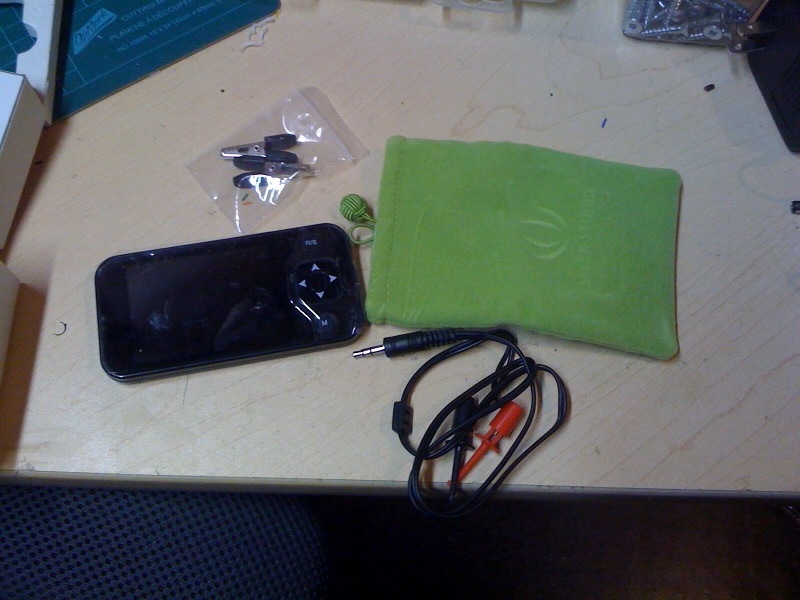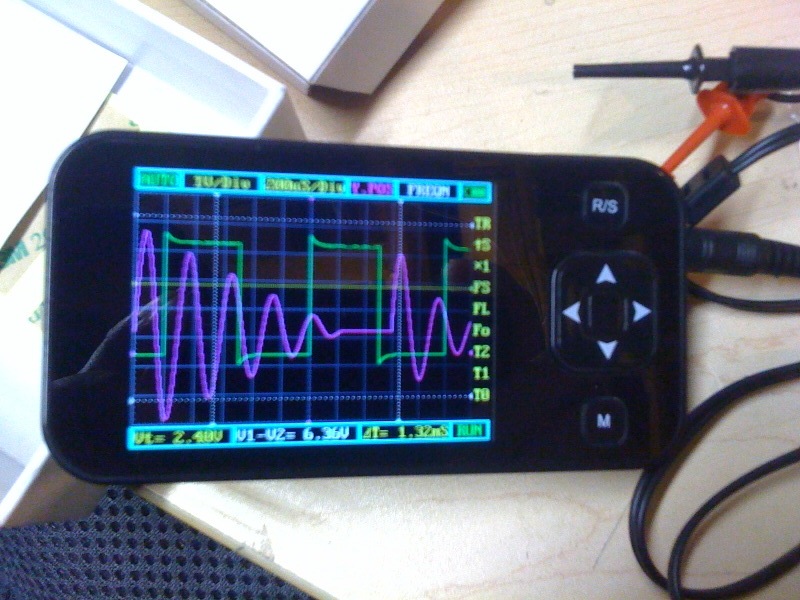
- Links Page
- Image Gallery
- Resistor Calc
- HomeBuilt IRDA module
- Remote Control IR
- Remote Control DIYUHF
- Remote Control DIYUHF V3
- Remote Control DIYUHF Plantraco compatible
- Battle Circuit for Heng Long Tanks
- DSO Nano review
- Power Meter Monitor
© <in der past>
Yay! My Seeedstudio DSO Nano arrived the other day, and I finally got a chance to take it for a spin.
I was surprised by how lightweight it is. It's definitely going to be easily portable, though from a few reviews I read, it sounds like you need to protect the screen from breakage when you carry it around. The plastic casing is a little "creaky" as it's been re-tasked from a cheap MP3 player, but serves it's purpose and probably contributes to the cheap price significantly. The backplate is nice aluminum, but is only stuck on with double-sided tape, which takes a little patience to get lined up just right before it grabs.

The package includes the DSO Nano, a carrying bag (though I'd be wary of carrying it without a hard case), a set of test clips (3.5mm on one end, lead clips on the other), a set of alligator clips to clip onto thicker wires, plus a brief manual. A USB cable (Type-A to mini-B) is needed for charging, and a micro-SD card (2GB or less) is useful if you want to save any waveforms. If you want to use a "regular" oscilloscope probe, you'll need a 3.5mm to BNC adapter, which Seeed sells separately.

However, I am very impressed by the functionality. The scope can easily show you a great deal of information on the screen, and calculate a number of important values. Frequency, duty cycle, various voltages, time and voltage between markers are all available (once you get used to the menu system). Trigger level and sensitivity can be adjusted as well. The screen is nice and vibrant, and easily viewed. USB charging is fine, and saves money by not requiring a dedicated charger.
The scope is a Digital Storage Scope, so it can be paused and you can scroll through the buffer to catch portions of the signal that aren't visible on screen. While the scope is only a single channel scope, it has the capability to save traces to the micro-sd card, and then display both a saved trace and captured trace simultaneously. This doesn't quite make up for not having a dual-channel scope (since there's no external trigger to sync the traces), but it's not too bad.
Overall, it's a good little single-channel pocket scope with digital storage capabilties. It's not a replacement for a true dual-channel scope for analog work, but it is pretty decent for small scale digital signals (servo PPM, slow digital comms, micro-controller learning).
- For those on a budget or with space constraints, it's a great digital alternative to the old "buy a used analog scope at a fleamarket" option.
- It's also a great portable scope. I've already used it a few times because it's much easier to drag around than my bigger scope, or when I'm afraid of crushing my RC airplanes with the bigger scope/cables.
Things that could be improved on:
- 2 channel would be awesome
- Higher sample rate
- Ability to scale the saved traces when you change the rate on the current trace (at least downsampling)
- Hard case to protect screen
- Easier menu navigation
Obviously, some of these changes would require hardware changes, so we won't see that until version two. I'd also say that any changes would need to be done without changing the price point too much. The price is good for a pocket scope, but only just on the edge of "beginner's first scope" considering the limitations.
Now, on the forums, there is discussion of a third-party firmware that has some usability enhancements, so I'll be trying that next, but wanted my review to represent the shipping scope and not a modded version.
Verdict: Recommended so long as your needs fit in the limitations, or as a portable 2nd scope.